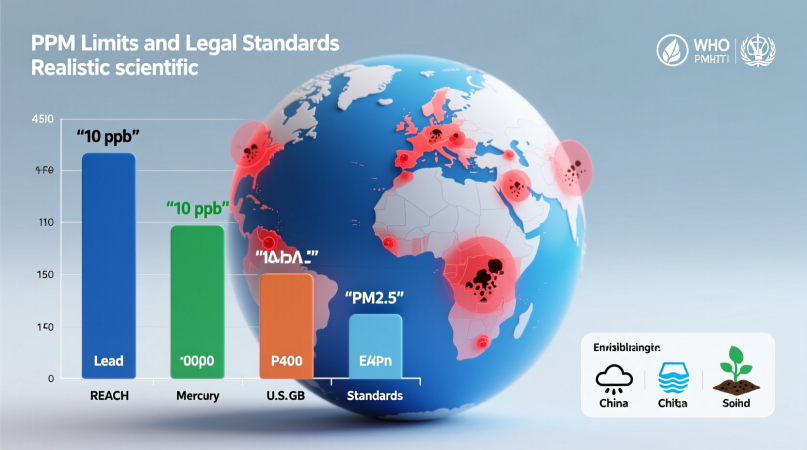
Environmental authorities use PPM (Parts Per Million) to track how much of a chemical or pollutant exists in air, water, and soil.
These limits define what’s safe for humans, wildlife, and the environment.
This guide compiles key legal PPM limits and international standards from agencies like the EPA, WHO, and EU Environment Directorate, plus examples of how to calculate or verify them.
Why Environmental PPM Limits Exist
PPM measurements allow regulators to control exposure to harmful substances at trace levels.
Governments use these limits to:
- Set air-quality standards
- Regulate industrial emissions
- Protect drinking-water sources
- Control soil contamination
If you’re new to the concept, start with What Is PPM and Why It Matters for background on how ppm expresses concentration.
1️⃣ Air-Quality Standards (EPA & WHO)
Carbon Dioxide (CO₂)
- Global outdoor baseline ≈ 420 ppm
- Indoor guideline: keep below 1000 ppm
Carbon Monoxide (CO)
| Agency | Limit | Exposure Time |
|---|---|---|
| WHO | 9 ppm | 8 hours |
| EPA (USA) | 9 ppm | 8 hours |
| EU | 10 ppm | 8 hours |
Nitrogen Dioxide (NO₂)
| Agency | Limit (ppm) | Duration |
|---|---|---|
| WHO | 0.106 | 1 hour |
| EPA | 0.100 | 1 hour |
| EU | 0.105 | 1 hour |
Sulfur Dioxide (SO₂)
| Agency | Limit (ppm) | Duration |
|---|---|---|
| WHO | 0.075 | 24 hours |
| EPA | 0.075 | 1 hour |
| EU | 0.125 | 24 hours |
You can model pollutant ratios with the PPM Calculator for Environmental Testing.
2️⃣ Water-Quality and Discharge Limits
Environmental laws also control industrial effluent and groundwater contamination in ppm.
| Substance | WHO Limit (ppm) | EPA Limit (ppm) | EU Directive (ppm) |
|---|---|---|---|
| Arsenic (As) | 0.01 | 0.01 | 0.01 |
| Lead (Pb) | 0.01 | 0.015 | 0.01 |
| Mercury (Hg) | 0.006 | 0.002 | 0.001 |
| Cadmium (Cd) | 0.003 | 0.005 | 0.005 |
| Nitrate (NO₃⁻) | 50 | 45 | 50 |
| Fluoride (F⁻) | 1.5 | 4.0 | 1.5 |
| Total Dissolved Solids (TDS) | ≤ 1000 | – | ≤ 1000 |
Compare these with your water test using the TDS to PPM Calculator or Molarity to PPM Calculator.
3️⃣ Soil-Contamination Benchmarks
| Element | Safe Level (ppm) | Risk Level (ppm) | Typical Source |
|---|---|---|---|
| Lead (Pb) | < 50 | > 300 | Paint / fuel residue |
| Arsenic (As) | < 20 | > 40 | Mining / industrial |
| Cadmium (Cd) | < 3 | > 10 | Fertilizer waste |
| Mercury (Hg) | < 1 | > 5 | Battery manufacture |
Use the PPM to Mass Calculator to estimate contaminant weight in sampled soil.
4️⃣ Legal Frameworks by Region
- United States: Clean Air Act and Clean Water Act specify ppm thresholds for emissions and discharges.
- European Union: Industrial Emissions Directive (2010/75/EU) limits heavy metals, nitrates, and SO₂.
- World Health Organization: Global recommendations under the Guidelines for Air and Water Quality.
- Australia & Canada: National Environmental Protection Measures (NEPM) and Canadian Water Quality Guidelines mirror WHO levels.
5️⃣ How to Check Compliance
- Collect a sample of air, water, or soil.
- Measure concentration using a lab or sensor.
- Convert readings to ppm via the PPM Calculator.
- Compare results to tables above or your region’s legal limits.
- Document and report findings if levels exceed national thresholds.
6️⃣ FAQs
What does “legal limit” mean in ppm?
It’s the maximum concentration legally allowed under environmental regulations for safety and health protection.
Are ppm limits the same worldwide?
No — they vary by climate, economic activity, and national standards. WHO values serve as a global baseline.
Can ppm be converted to percent or ppb?
Yes — 1 ppm = 0.0001 % = 1000 ppb. See our PPM Conversion Table for quick conversions.
Summary: Global Environmental PPM Limits
- Air pollutants like CO, NO₂, and SO₂ are controlled at single-digit ppm levels.
- Water contaminants such as arsenic, lead, and fluoride are capped between 0.01 – 4 ppm.
- Soil heavy-metal thresholds generally range from 10 – 300 ppm, depending on element and land use.
- Always verify data with the Online PPM Calculator or your local environmental regulations.
Robert is the creator of ppmcalculator.com, dedicated to providing accurate and easy-to-use calculation tools for parts per million (PPM) and related scientific measurements. With a strong commitment to precision and user-friendly design, Robert helps users save time and make informed decisions. His clear, helpful content empowers students, professionals, and hobbyists alike to tackle complex calculations with confidence.
